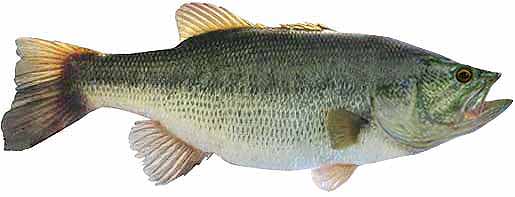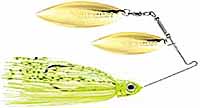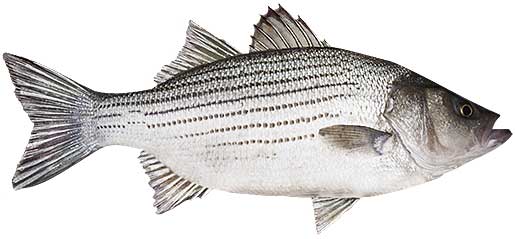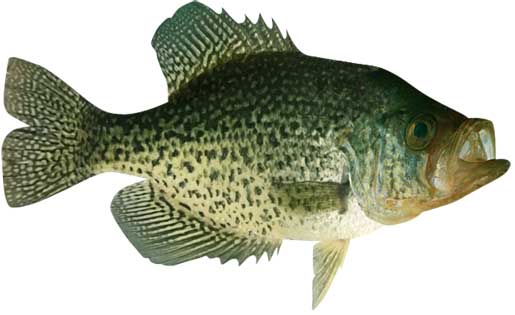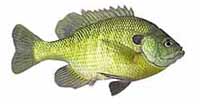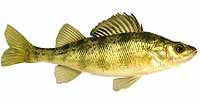Fishing Report For Manasquan Reservoir, NJ
By Rick Seaman
Last updated on .
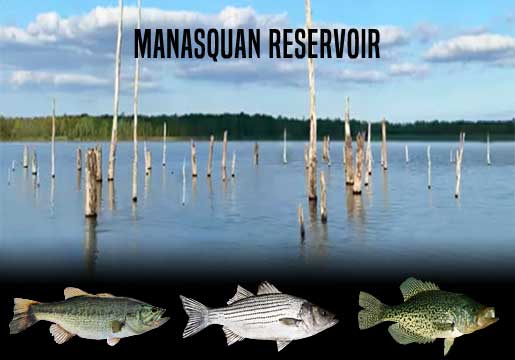
Fishing Reports
Popular Fish Species Manasquan Reservoir, NJ
Largemouth Bass
Current Report: Good
FALL. Now that Fall has arrived, bass here have moved shallow, following schools of baitfish into coves and shallow bays around 5 to 20 feet of water. Tournament anglers report stick worms, rigged wacky style are a go-to bait when the bite slows down. The North Fork, Middle, and South Fork Timber Swamp Brook are loaded with timber, brush and vegetation, and are reportedly good spots to catch nice bass. Locals enjoy spinnerbait fishing for these bass that are eager to eat. Currently topwater, jerkbaits, crankbaits, and slow-rolled spinnerbaits are catching most of the bass. Later in Fall, as deeper water cools, bait and bass move out to ledges, channel edges, points and humps where flutter spoons, jigs and drop shots are often good choices in 15 to 25 feet of water.
WINTER. Winter will isolate largemouth around slightly deeper structure, flats, points and creek channels. They can be found from 20 to 35 feet deep. Here they hold, feeding less frequently, awaiting warmer water to return in Spring. Slow presentations are key to getting bites. On warmer days, especially during late afternoons, bass may move into 12 to 15 feet of water to feed. Slow-moving swimbaits can be a deadly bait when fished deep.
SPRING. Once water temperatures rise into the low 60's, largemouth will move from deep wintering holes, to shallower water nearby spawning areas. Vibrating jigs, jerkbaits and spinnerbaits typically get bites just away from the shoreline. At this time they are feeding aggressively in about 2 to 15 feet of water, and preparing for the spawn. Once water warms into the mid to high 60's, they will move into 2 to 6 feet of water, and create nests, then lay their eggs. Immediately afterwards, females move to deeper water and males remain to guard the eggs, and then the fry. After a couple weeks, the males also move to slightly deeper water. Deep-diving crankbaits, vibrating jigs, plastic worms and swimbaits are catching bass during this period.
SUMMER. Water temperatures will warm considerably in Summer. Bass will feed shallow, early and late in the day, where they will be caught in 8 to 12 feet of water, on square-bill crankbaits and spinnerbaits. Wacky-rigged stick worms always catch finicky bass when the bite is slow. Manasquan Reservoir is loaded with standing trees, lay-downs and brush. Bass love this cover because it attracts bait and sunfish, making it a great place for bass to enjoy lunch. Largemouth bass here feed on shad, herring, small sunfish and crawfish. During the hotter parts of the day, they are being caught on points, channel edges, and ledges 15 to 25 feet deep. Some of the best reports seem to be from anglers fishing in the area around the dam.
Hybrid Striped Bass
Current Report: Fair To Good
FALL. In Fall, hybrid stripers return to shallow water, the upper end of the lake, and into inflowing water if available. Early in the day wipers chase bait to the surface and feed aggressively, making this an excellent time for topwater action. Mid day they move into 10 to 25 feet of water. Look for structure nearby deeper sections in channels, and fish them thoroughly. Most any lure that resembles shad will catch wipers at this time of year.
WINTER. In Winter, hybrid stripers again hang out in deeper water and feed close to the bottom, often 40 feet deep or deeper. Warm afternoons occasionally draw stripers shallower, so look for them around the 20-foot range as they feed on roaming schools of gizzard shad. In Winter it is important to locate schools of bait, then look for wipers schooling below the bait. Fish finders, and forward facing sonar, are a big help in locating these roaming schools. Nice fish are being caught while trolling or drift fishing. Spoons, swimbaits, blade baits, crankbaits, live bait and cut bait are typically effective this time of year. Due to slower metabolism, anglers are triggering more strikes by making slower presentations.
SPRING. When water temperatures rise into the mid 60's now, it's the ideal time for hybrid stripers to spawn. These sunshine bass will feed in 5 to 20 feet of water. There are plenty of hybrids averaging 2 to 3 pounds, with an occasional 5-pound plus fish being caught. In Spring, work wind-blown points, creeks, and the western section of the lake if there is inflowing water. If they spawn, they will lay eggs in flowing water. Look for deeper holes in the river channels, as they are a good holding place for hybrid stripers after the spawn.
SUMMER. In Summer, these wipers typically hang out in 15 to 35 feet of water, staying close to schools of bait. Hybrids prefer to stay in the main lake area where water up to 40' is available. It is also where the baitfish spend a majority of their time. These wipers run in packs and can be caught on almost any lure that resembles baitfish. Jerkbaits, cast or trolled are popular here, especially in shad patterns. Swimbaits, crankbaits, spoons, live bait and cut bait are all effective here as well. Sometimes during the heat of the day they move close to the bottom, 35 to 40 feet deep. Morning often draws hybrid stripers to much shallower water, so look for them around the 10 to 20-foot range as they feed on shallow, roaming schools of gizzard shad. Being successful at fishing for stripers in Summer is a matter of locating schools of bait, and the wolf packs of wipers are likely to be nearby. Fish finders, and sonar electronics, are a big help in locating these roaming schools. Nice wipers are being caught by casting, trolling or drift fishing. Spoons, blade baits, crankbaits, live bait and cut bait are all effective here.
Black Crappie
Current Report: Fair To Good
FALL. Baitfish, which are moving into shallow flats, coves and bays, are drawing crappie into these areas. Even though the water level has been fluctuating, locals still report crappie fishing has been fairly good in Manasquan Reservoir. Nice crappie are being caught while feeding heavily, in preparation for the cold Winter. Anglers report that 8 to 15 feet of water is where most bites are coming. Minnows, hair jigs, and crappie jigs, are good options during this feeding marathon. Late fall starts the migration deeper, toward winter holding areas, for both crappie and baitfish. Small flutter spoons, fished in 15 to 20 feet of water, are a good option during this transition. Good results are coming around points, creek channels, and brush piles.
WINTER. Once the shallows start cooling rapidly, crappie will migrate to deeper holding areas, mostly off shore. At this time they are typically caught using a very slow presentation, in 20 to 35 feet of water. Most are caught around deep brush piles, creek channel bends, submerged timber, and main-lake structure. The west half of the lake is a good area in Winter. If they are suspending in open water, they often relate to some cover, or structure change, directly below them. During warming trends, especially warm afternoons, they are drawn into 8 to 15 feet of water to feed.
SPRING. In early Spring, crappie begin staging in 3 to 12 feet of water, just outside spawning bays and shallow flats. Spring is prime time to be on the water, as crappie have moved shallow to spawn. The North Fork Timber Swamp Brook, Middle Fork Timber Swamp Brook and South Fork Timber Swamp Brook are loaded with brush, trees and vegetation. At that time, they are typically caught in 2 to 8 feet of water. Vegetation, docks, brush and wood are where most anglers catch crappie using small crappie jigs or live minnows. After the spawn, crappie typically move outside the spawning area and hold on cover close by, in 5 to 15 feet of water. Once they move deep, anglers report success using fish finders and forward facing sonar to locate schools of crappie, which tend to stack vertically around cover. Light tackle, with 4 lb to 8 lb line, is a popular choice.
SUMMER. Water temperatures get quite warm, and crappie fishing is usually pretty good. They feed in 10 to 15 feet of water early and late in the day, until the hot Summer sun causes them to retreat to depths of 15 to 22 feet. Also, a few have embedded in the shade of slightly shallower vegetation. This is a good time to focus around brush piles, standing timber, and deep lay downs. Anglers are also locating schools of crappie hanging above deeper structure and timber, using fish-finder electronics.
Fishing Video
Fish species to fish for...
Guide to fishing for largemouth bass, smallmouth bass, channel catfish, black crappie, bluegill, yellow perch, hybrid striped bass, chain pickerel and tiger muskie at Manasquan Reservoir in New Jersey.
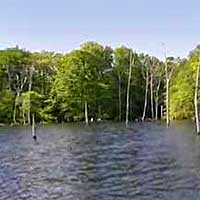 Manasquan Reservoir 770-acre reservoir with about 8 miles of shoreline, some of which is accessible for shoreline fishing-particularly along the 5-mile perimeter trail. Bass, hybrid stripers and crappie are the main draw here.
Manasquan Reservoir 770-acre reservoir with about 8 miles of shoreline, some of which is accessible for shoreline fishing-particularly along the 5-mile perimeter trail. Bass, hybrid stripers and crappie are the main draw here.
Primary fish species to catch
Click images for fishing tips and details about each species.
Today's Weather & Forecast
Public Boat Launch Ramps & Landings
Click here for fishing boat rentals.
Fishing License
Click here for a New Jersey Fishing License.
Map - Fishing & Access
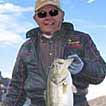 Rick Seaman is a fishing enthusiast with over five decades of fishing experience, a retired tournament fisherman, author of numerous published articles on fishing, and co-author of the book "Bass Fishing - It's not WHAT you throw, It's WHERE you throw it".
Rick Seaman is a fishing enthusiast with over five decades of fishing experience, a retired tournament fisherman, author of numerous published articles on fishing, and co-author of the book "Bass Fishing - It's not WHAT you throw, It's WHERE you throw it".
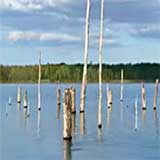 Contact Information
Contact Information
Allaire State Park
Atlantic Ave
Howell, NJ 07731
732 938-2371
Fishing lakes in each state
102725
Manasquan Reservoir, NJ Report
NEW JERSEY


Information about fishing lakes in New Jersey
Manasquan Reservoir offers bass, catfish, crappie, chain pickerel, perch, bluegill and tiger muskie fishing in central NJ.


